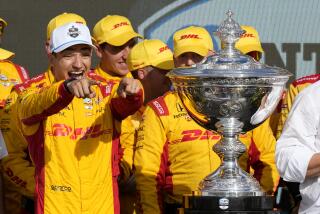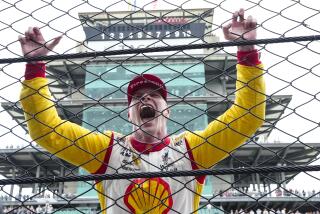Guerrero Waits, Helmet in Hand, for a Call : Auto racing: Twice a winner in Indy cars and with success at Indianapolis, he wants to drive again.
- Share via
The Indianapolis Motor Speedway, where Roberto Guerrero’s promising racing career almost ended in a terrifying crash four years ago, might provide the showcase that will put his career back on track.
Guerrero, a winner in Championship Auto Racing Teams Indy cars before the accident, has spent most of the 1991 season sitting at home in San Juan Capistrano, waiting--and hoping--for a call to rejoin the circuit.
Kenny Bernstein, the drag racing champion who owns Indy cars, called recently, and Guerrero, a Colombian who became a U.S. citizen last year, responded by bettering the Indy track record during a test in one of Bernstein’s Lola-Buicks.
“We ran 226.7 (m.p.h.) there and ran laps consistently over 225,” Guerrero said.
The Indy qualifying record is 225.575 m.p.h. by Emerson Fittipaldi in 1990. Rick Mears sat on the pole for the Indianapolis 500 last May with a speed of 224.113.
“Conditions were ideal--cool with no wind--when we ran, but the speeds were very exciting,” Guerrero said. “We completed 248 miles of what was to be a 500-mile race test, and the car ran very well. If CART changes the rules for next year to help make the Buick more competitive on tracks other than Indianapolis, I will probably run 12 races for Bernstein.”
The late-season turn of events is quite a contrast to the discouraging years Guerrero has experienced since his car smashed into a wall during a tire test Sept. 10, 1987.
The accident occurred shortly after Guerrero had won his second Indy car race and he was only nine points out of second place in the drivers’ standings. He had finished second in the Indianapolis 500, making him one of the most consistently high-finishing drivers in the race’s history without a victory. In his first four starts, he was second, third, fourth and second.
Then came the accident, a 180-m.p.h. slide into the second-turn wall. The right front wheel tore loose, ricocheted off the concrete barrier and smashed into his helmet. He did not regain consciousness for two weeks.
Few expected him to return to the track, but Guerrero and his wife, Katie, who was living in Tustin when she met him while vacationing in Monte Carlo, said he never thought about not racing. When the season opened the next spring, Guerrero finished second at Phoenix.
“I thought I was back, ready to resume my career with Michael (Andretti), Little Al (Unser), (Bobby) Rahal and the other guys at the top,” Guerrero said at his hillside home. “I found out that results aren’t all that counts, however. To get a ride these days, a driver needs to bring money, or a sponsor, which is the same thing. They are more important than your helmet and gloves.”
Guerrero, twice a winner in Indy cars, has been sitting on the sideline while seven drivers who have never won--Eddie Cheever, Scott Pruett, Scott Brayton, Scott Goodyear, Tony Bettenhausen, Jeff Andretti and Hiro Matsushita--have driven in all 16 CART races this year.
“I’m only 32, younger than a lot of Indy car drivers, and I think I’m as sound as ever,” Guerrero said. “It is getting more and more difficult to get a ride without bringing money or a sponsor. Until Kenny called, prospects were quite discouraging.
“You get an idea of how tough it is to get a sponsor when you see Vince Granatelli, with Arie Luyendyk, an Indy 500 winner, as his driver in competitive equipment, fielding a virgin car--that’s one with no sponsor decals on the sides. If he can’t get a sponsor, what’s the future for the rest of us?”
And ever since that second place at Phoenix in the opening race of 1988, Guerrero’s career has been a nightmare.
At Indy, after qualifying 12th at 209.633 m.p.h, seventh fastest among non-Chevrolet-powered cars, his hopes were dashed on the second turn of the first lap when Brayton spun in front of him, leaving him with no place to go. The rest of the year wasn’t much better as Guerrero struggled to compete with waning Cosworth power against the all-winning Chevys.
In 1989, Guerrero signed with the new Alfa Romeo team, hoping that it would become the fulfillment of his career. It never happened. After two years of testing and working to make the Alfa competitive, he was dumped when the project stalled.
“That made me really mad,” Guerrero said. “I knew when I joined Alfa that it would take some time, several years or more, to develop the engine to where it could compete with the Chevys. The engine had a lot of potential, and I really felt, after I saw all the equipment and personnel the factory was putting into the effort, that I could be capable of winning every race within two years. I think the biggest problem was that there were too many hands in the effort.
“Instead of one person being in control, it seemed like six or seven people had to pass on every decision. Maybe that’s the way things work in big corporations, but it doesn’t work with a race team.
“There always has to be a scapegoat. The first year, it was (crew chief) Johnny Capels because the car wasn’t ready until after Indy. Then last year, it was me because we never finished higher than fifth and rarely finished. It was very frustrating. I just wasted two years of my career.
“I don’t know who the scapegoat will be this year, but I wouldn’t be surprised if Alfa pulls the plug on the whole program. Danny Sullivan has already jumped ship by announcing he’s going to be (Al Unser Jr.’s) teammate next year with Galles.”
Guerrero was put in a difficult position for 1991 because he knew he would not be rehired until too late in the 1990 season to begin negotiations with a new team.
“The timing was bad,” Guerrero said. “The economy was going sour, which made finding sponsors very difficult, and there were no seats empty in the few cars that were going to run this year.
“People ask me why someone can’t run a car with little or no sponsorship, and I tell them it costs a minimum of $5 million for a one-car, one-driver team to be halfway competitive. I haven’t found anyone who has that kind of money in his pocket without a commercial sponsor.”
Guerrero has had four rides, with three owners, this year, but none was in competitive equipment.
He drove a backup Alfa for Pat Patrick at Indianapolis, Buicks for Bernstein at Detroit and Denver and a Lola-Cosworth for Euromotosports at Toronto. Next week he will be in Bernstein’s car again at Laguna Seca.
None of them finished, but the most frustrating race was Indy, where he was taken out early in a collision with Kevin Cogan. Worse than crashing for Guerrero were the postrace comments of Cogan, who said Guerrero caused the accident.
“I’ve always had a good relationship with Kevin,” Guerrero said. “That’s what makes me so mad, the way he goes around blabbering about how I caused the accident. I never blame another driver because I know how things happen during a race. I know that nothing happened on purpose, especially at Indy where it is so dangerous, but all you have to do is look at the video of the accident to see that I did not do what he said I did.”
Guerrero popped a video of the accident into the VCR in his living room and pointed out that his No. 40 car held its line through the first turn until it was hit in the rear by Cogan’s No. 9, a blow that sent both cars spinning into the wall.
“The ABC picture did not pick up the accident until both cars were in the wall,” Guerrero said. “But a few days after the race, an Indianapolis TV station got some film taken by a spectator. It shows clearly what happened, and it certain absolves me of any blame.
“I know Cogan has seen the film, because the TV station contacted him, which makes it even more puzzling to me to have him repeat what he said earlier. . . . From what I can see, it appears that Kevin got into some turbulence, which can be really bad early in the race, and couldn’t help what happened.”
Guerrero would like to put the Indy incident in the past, but he keeps the video handy.
“I would rather get on with my career than rehash the past,” he said. “If I can make the Buick run well at Laguna Seca and go on from there into next year, I’ll feel like I’m back.”
He smiled at the thought. Most of this year has been spent sitting and waiting, romping with his sons, Marco and Evan Michael, and playing golf and tennis with his wife.
“It’s been fun being at home, but I’d rather it be between races, not instead of races,” he said. “I begin to feel very uncomfortable when there’s a race going on and I’m not racing.”
More to Read
Go beyond the scoreboard
Get the latest on L.A.'s teams in the daily Sports Report newsletter.
You may occasionally receive promotional content from the Los Angeles Times.










